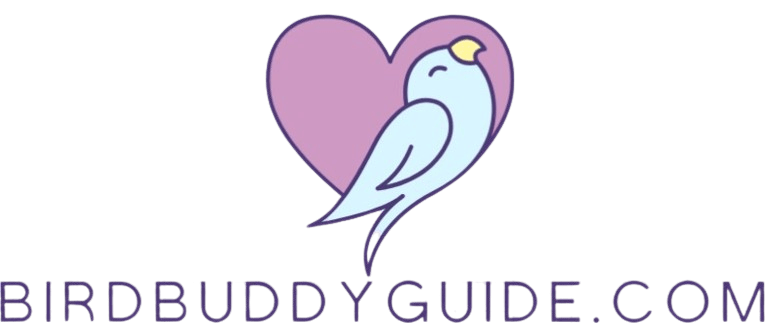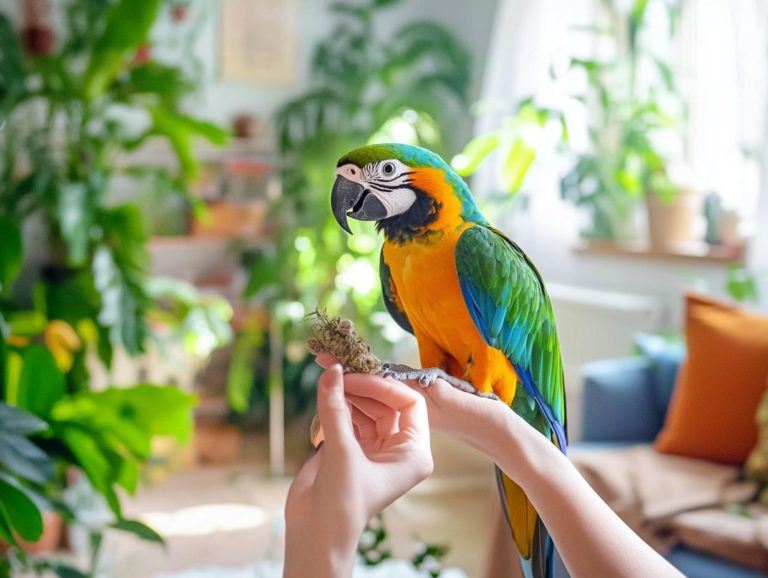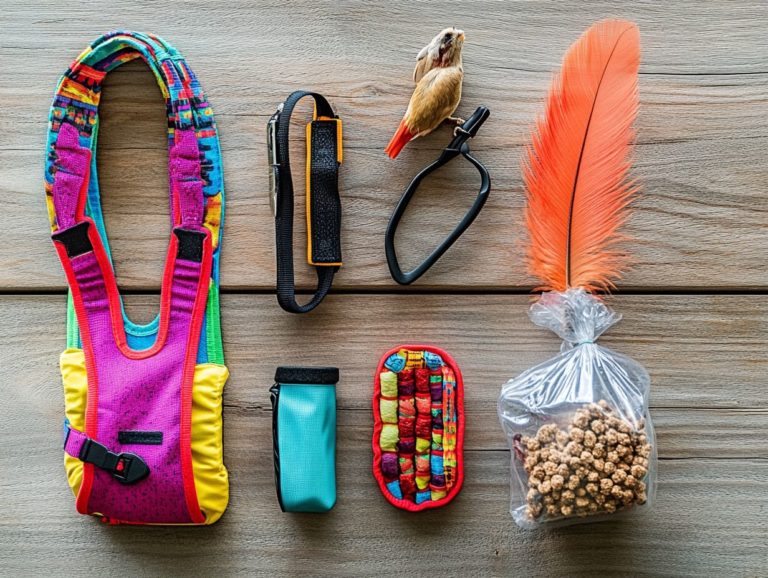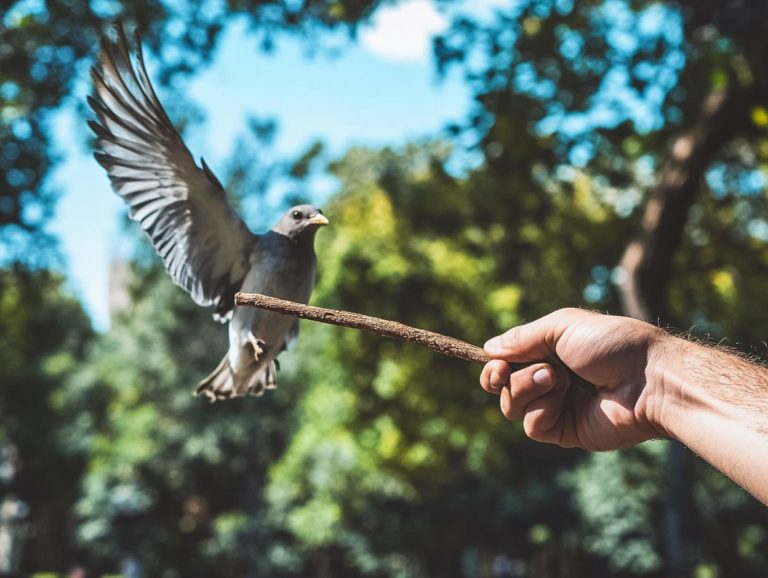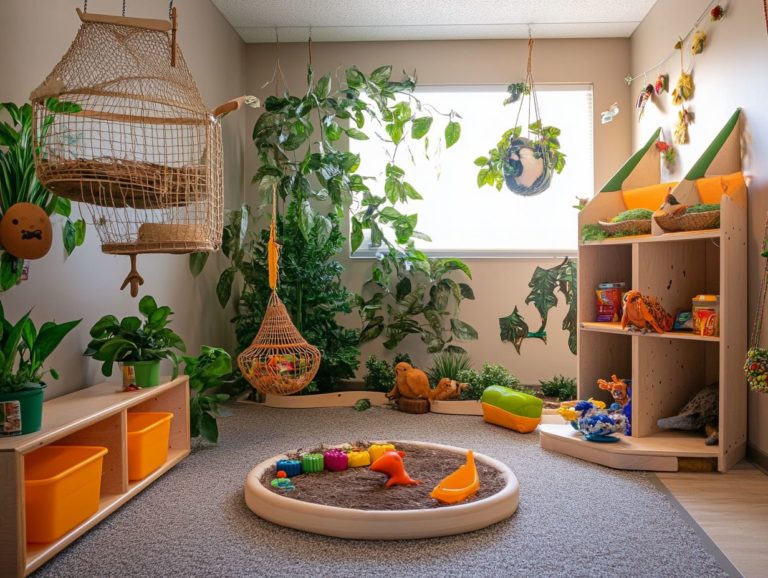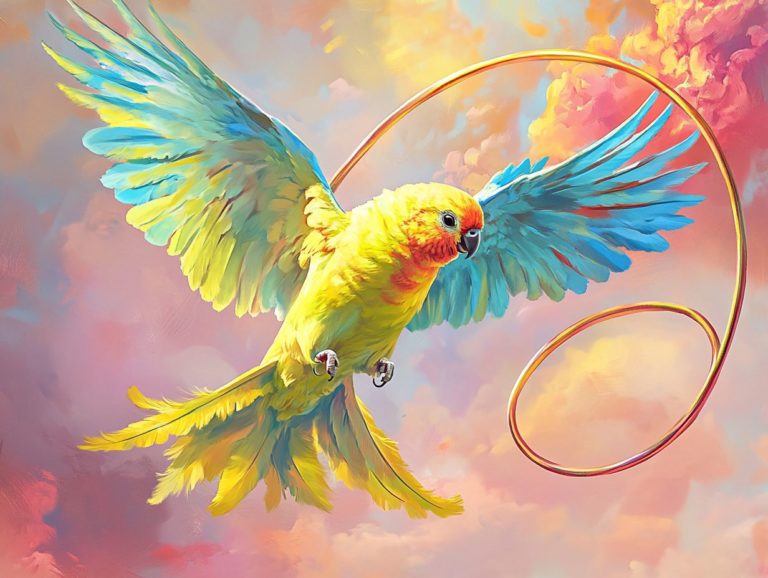How to Use Toys in Bird Training
Training your bird goes beyond merely teaching tricks; it s a fundamental aspect of their overall well-being. By engaging your feathered companion with the right toys, you can pave the way for a happier, more enriched life.
In this article, we ll explore the diverse types of toys that can elevate your bird training, from interactive options to foraging toys that stimulate their natural instincts. You’ll also find guidance on selecting the best toys and effective training techniques, while avoiding common pitfalls. Get ready to unlock your bird’s amazing potential today!
Contents
- Key Takeaways:
- The Importance of Training for Birds
- Types of Toys for Bird Training
- How to Choose the Right Toys for Your Bird
- Training Techniques Using Toys
- Common Mistakes to Avoid
- Frequently Asked Questions
- Want to know how toys can supercharge your bird’s training? Here s how!
- What types of toys are best for bird training?
- How do I introduce toys to my bird during training?
- Can I use my bird’s favorite toy as a reward during training?
- How often should I rotate my bird’s toys during training?
- Are there any safety precautions I should take when using toys in bird training?
Key Takeaways:
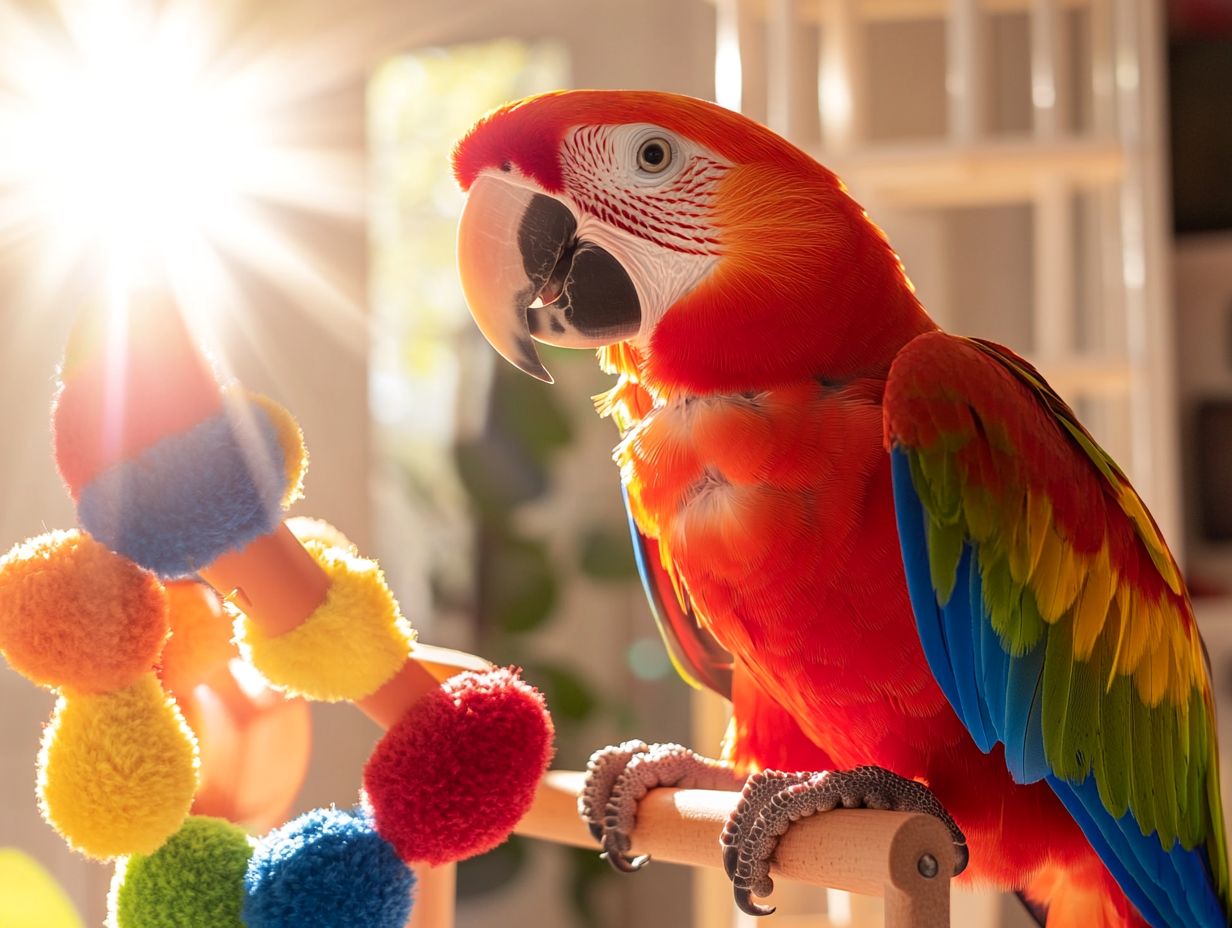
- Training helps your bird live a happier life!
- Choose interactive, puzzle, foraging, and flight toys for effective bird training.
- Consider your bird’s size, breed, and preferences when selecting toys. Use toys in training to build trust, stimulate natural behavior, and reinforce positive behavior.
The Importance of Training for Birds
Training is a vital component of ensuring a happy and healthy life for birds, especially for interactive species like parrots that thrive on engagement and mental stimulation. By committing to regular training, you not only enhance their behavior but also promote their emotional well-being.
Training is also a proactive way to address common behavioral issues that can arise from boredom or a lack of attention. This makes it an essential part of your bird’s daily routine and overall satisfaction. By incorporating targeted activities and utilizing positive reinforcement techniques, you can cultivate an enriching environment that fosters independent play and interaction.
Why Training is Essential for Birds
Training is essential for your birds, as it promotes their emotional well-being and helps you manage their behavior effectively.
Establishing a structured routine can significantly enhance their emotional stability, reducing anxiety and fostering a sense of security. This process curbs negative behaviors like excessive screeching or biting and encourages positive social interactions.
As you engage regularly with your feathered companions, you ll cultivate a strong bond that enhances trust and understanding. Over time, this emotional connection deepens, paving the way for more profound interactions that enrich both your lives.
Training creates an environment where your birds feel safe to explore and express themselves creatively, leading to an overall happier and healthier pet.
Types of Toys for Bird Training
In the realm of bird training, selecting the right toys is essential for getting your bird excited to play and enriching the experience for both of you. Birds, especially parrots, thrive on stimulation and engagement. They need a variety of activities to maintain their attention and stave off boredom.
Each type of toy serves a distinct purpose from promoting independent play to facilitating foraging activities that reflect their natural instincts. Choosing the appropriate toys not only enhances their environment but also nurtures positive emotional connections, making them essential tools in your training repertoire.
Interactive Toys
Interactive toys for birds are crafted to spark their natural curiosity and inspire active participation in play. These innovative toys often showcase vibrant colors, diverse textures, and delightful sounds, all of which engage their senses and grab their attention.
By incorporating puzzles, switches, and hidden treats, these toys challenge birds mentally, promoting thinking skills that mirror their foraging instincts in the wild. For instance, imagine a puzzle toy that requires your bird to manipulate pieces to unveil a treat; not only does it provide entertainment, but it also nurtures their problem-solving abilities.
The psychological benefits of such play are profound. Engaging toys can significantly reduce boredom, curb aggressive behaviors, and enhance overall well-being. When you offer your feathered friend the chance to play with these thoughtfully designed toys, you ll witness increased social behaviors, improved emotional health, and a noticeably enriched quality of life.
Puzzle Toys
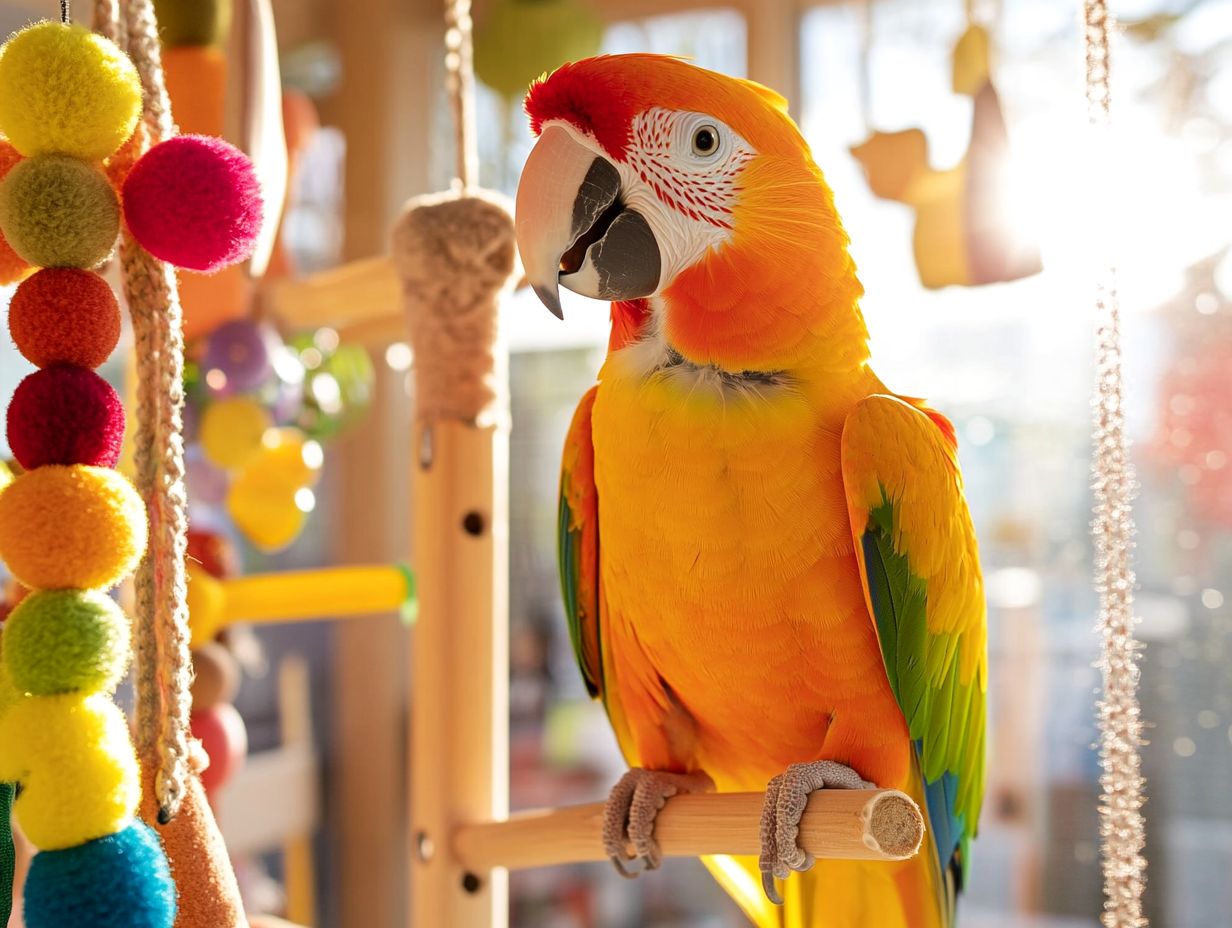
Puzzle toys are amazing tools for keeping your bird s mind sharp.
These fun toys challenge your feathered friends to think and solve problems, improving their focus and persistence.
As they engage with these toys, birds tap into their natural instincts, leading to joyful play that boosts their mental health.
Using these toys regularly helps prevent boredom, making them essential for your bird’s happiness.
Foraging Toys
Foraging toys mimic natural behaviors, allowing birds to explore and hunt for treats.
This play is vital for their psychological well-being and helps reduce boredom and stress.
When birds engage in foraging, they feel a sense of achievement, which is fulfilling.
Incorporating foraging into training builds trust and strengthens your bond with your bird.
Flight and Exercise Toys
Flight and exercise toys are key to keeping your bird physically healthy.
These toys promote active play and create a stimulating environment.
Offering chances to climb, swing, and fly boosts fitness and agility.
Regular movement decreases stress and leads to happier, more stable birds.
How to Choose the Right Toys for Your Bird
Selecting the right toys is essential for a fulfilling environment.
Consider your bird’s species, personality, and needs to ensure the toys engage and stimulate them.
Factors to Consider
When choosing toys, consider what fits your bird s personality and training needs.
The toy’s size is important; it should suit your bird s breed to avoid injury.
Choose safe, non-toxic materials like wood or fabric to keep your bird curious.
Understanding whether your bird is inquisitive, shy, or playful enhances engagement.
A playful bird might love bright, moving toys, while a reserved one may prefer calmer options.
By considering these factors, you create a more enriching experience that keeps your bird happy and engaged.
Training Techniques Using Toys
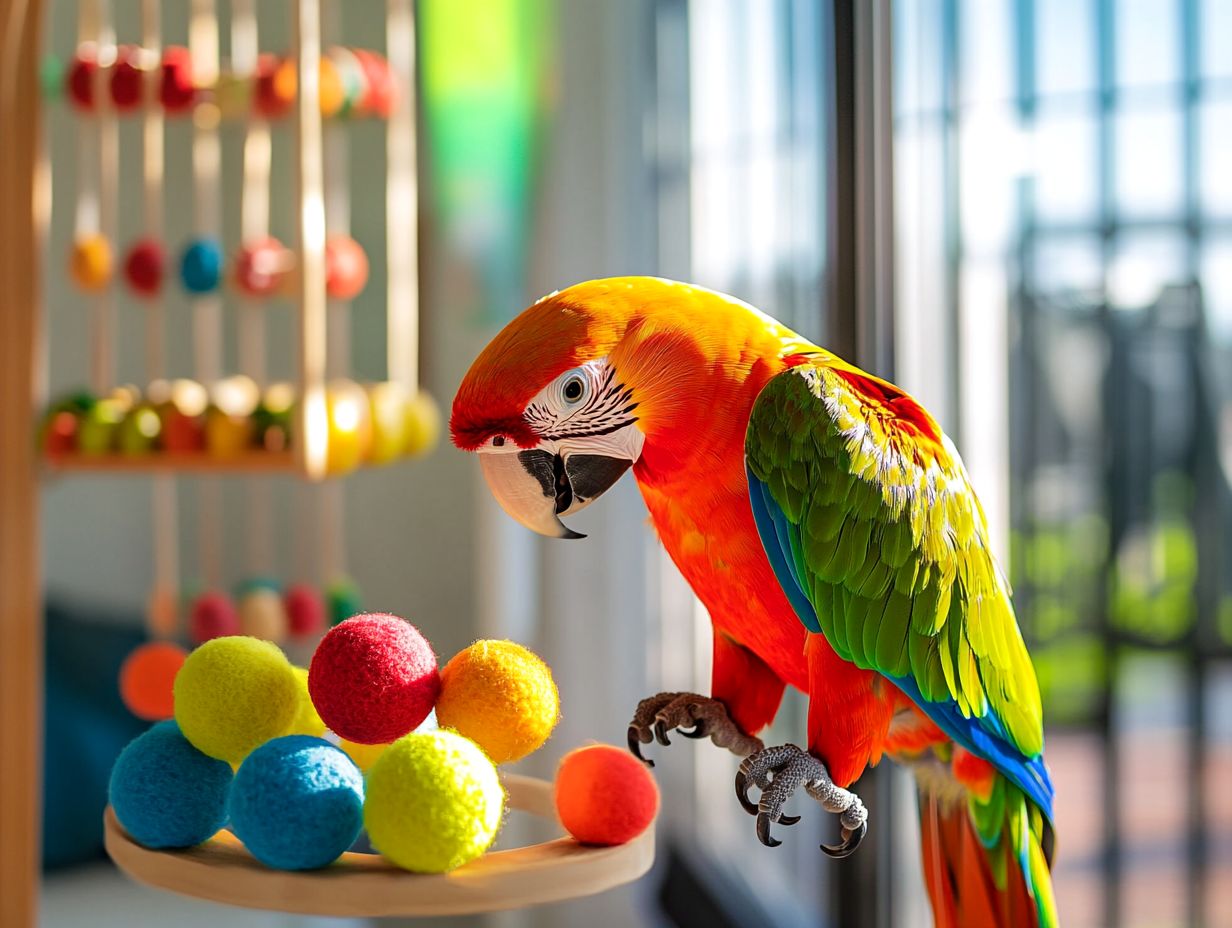
Training techniques that incorporate toys can profoundly elevate a bird’s learning capabilities and interaction with its surroundings. To enhance your methods, consider exploring the best training techniques for pet birds, which prioritize positive reinforcement.
By utilizing a range of methods, you can teach your bird new behaviors, encourage independent play, and enhance its overall quality of life.
Integrating toys into training sessions not only transforms learning into an enjoyable experience but also highlights the role of play in bird training. This method strengthens the bond between you and your feathered companion, paving the way for effective behavior management and nurturing emotional well-being.
Step-by-Step Guide
A step-by-step guide to training techniques gives you the power to effectively use toys for understanding bird behavior and enrich your birds’ lives.
By integrating fun and engaging toys into their daily routines, you can stimulate your feathered friends mentally while enhancing the bond you share.
The key lies in selecting toys that encourage interaction. This allows your birds to explore and play while learning essential cues.
When introducing new toys, watch their reactions closely for amazing insights into how they’re learning. Establish clear behavioral expectations so they can grasp what you desire.
Use positive reinforcement, like treats or praise, to reward your birds. This transforms the training process into an enjoyable and successful experience. It fosters a playful learning environment, cultivates healthy habits, and deepens your connection with your birds.
Common Mistakes to Avoid
Avoiding common mistakes in bird training is essential for cultivating a successful and enriching experience for both you and your feathered companion. Many owners unintentionally sabotage their training efforts by overlooking key elements such as attention spans, consistency, and the thoughtful application of positive reinforcement.
By recognizing these pitfalls, you can establish a more effective training environment that promotes healthy behaviors and emotional well-being for your bird.
Tips for Successful Training
- Successful training demands careful consideration of various factors that influence a bird s learning and behavior.
- To enhance the effectiveness of each training session, embrace attention management techniques. Keeping sessions short and focused can significantly boost a bird s receptivity to new commands or tricks.
- Use positive reinforcement strategies; rewarding your bird with treats or praise encourages desirable behaviors and fortifies the learning process.
- Incorporate interactive activities such as puzzle toys or games to capture your bird s interest and promote mental stimulation.
- By weaving these strategies into your training routine, create engaging experiences that foster better communication and connection with your avian companions.
Frequently Asked Questions
Want to know how toys can supercharge your bird’s training? Here s how!
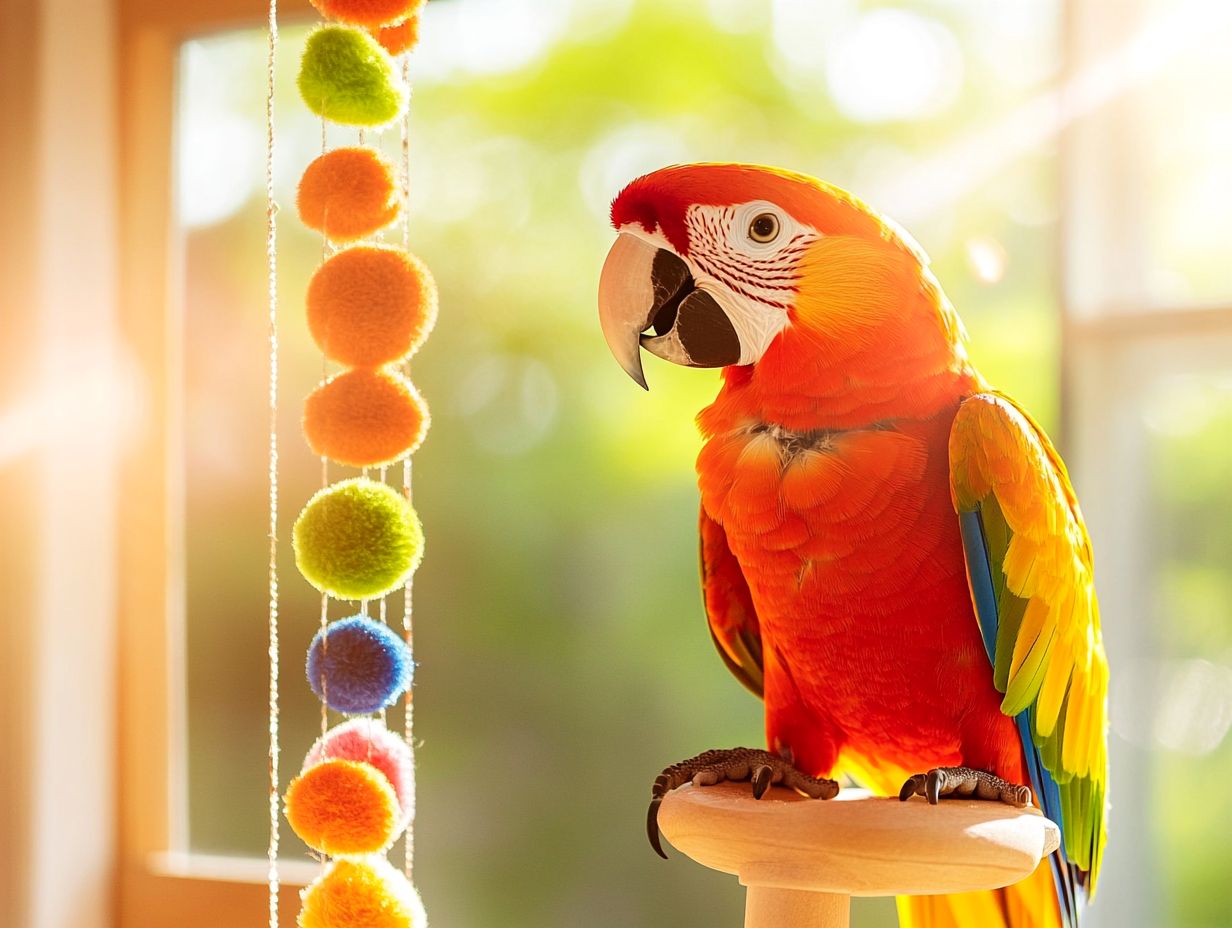
Toys provide mental and physical stimulation for birds. They keep them engaged and prevent boredom. Toys also help develop dexterity and problem-solving skills, strengthening the bond between the bird and owner.
What types of toys are best for bird training?
Toys that encourage natural behaviors, such as foraging and chewing, are ideal for bird training. For example, consider exploring the top 7 toys for teaching birds new tricks, which can include puzzle toys, hanging toys, and foot toys made of safe materials like untreated wood and natural fibers.
How do I introduce toys to my bird during training?
Start by offering the toy in a neutral environment and observe your bird’s reaction. If they show interest, praise and reward them. Gradually move the toy closer to the training area and incorporate it into training exercises. For some great options, consider the top 5 toys for training your bird. Be patient and never force your bird to interact with a toy.
Can I use my bird’s favorite toy as a reward during training?
Yes, using a desired toy as a reward can be a great motivation for your bird during training. However, you might also consider using treats for effective bird training to keep sessions interesting and prevent your bird from becoming overly attached to a specific toy.
Get started today and see your bird thrive!
How often should I rotate my bird’s toys during training?
Keep things fun for your bird! Rotate a few toys every week to keep them excited and engaged.
Are there any safety precautions I should take when using toys in bird training?
Safety first! Check that toys are bird-friendly. Always watch your bird while they play to ensure their safety. Inspect toys regularly for wear, and remove any damaged ones immediately to prevent accidents.
